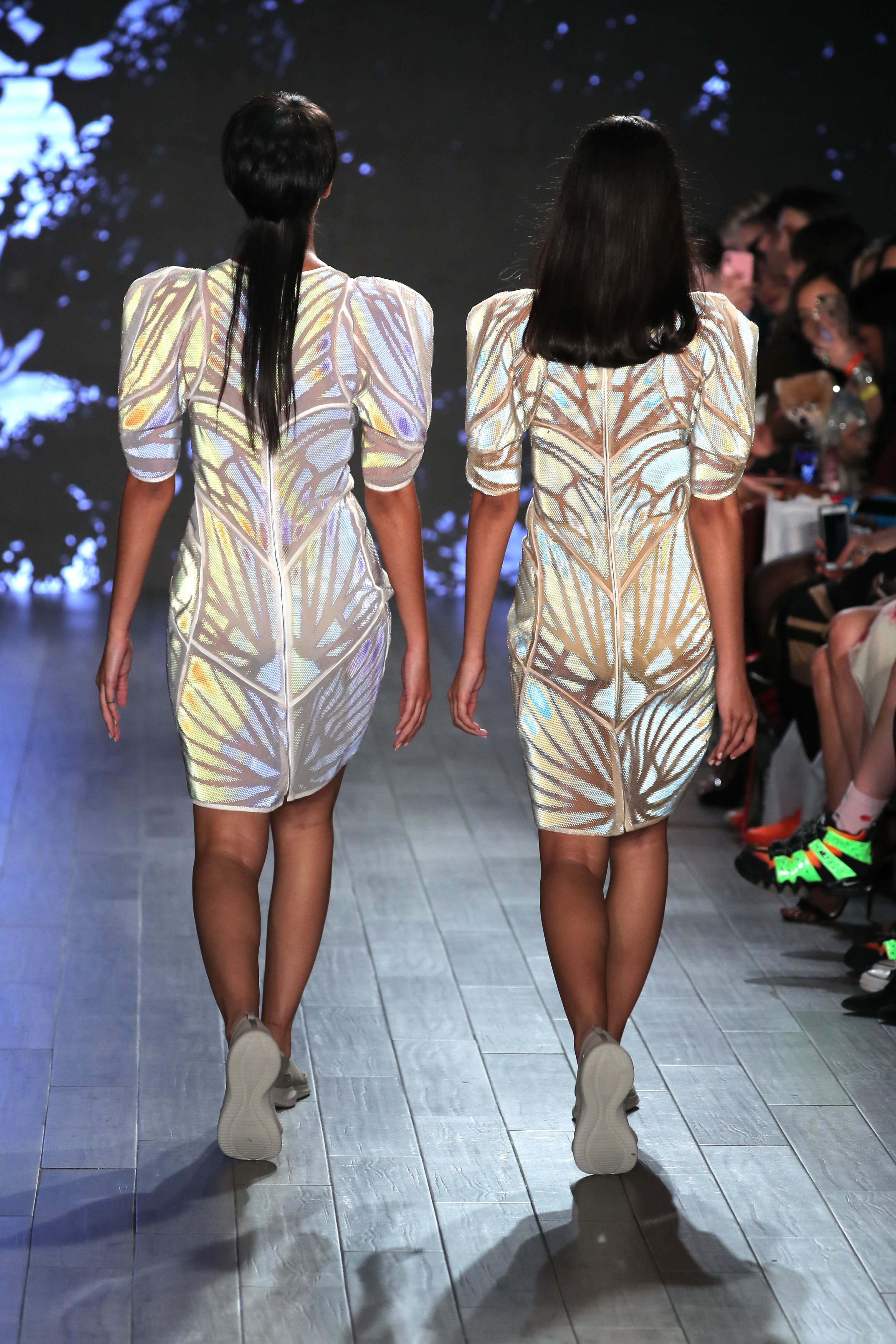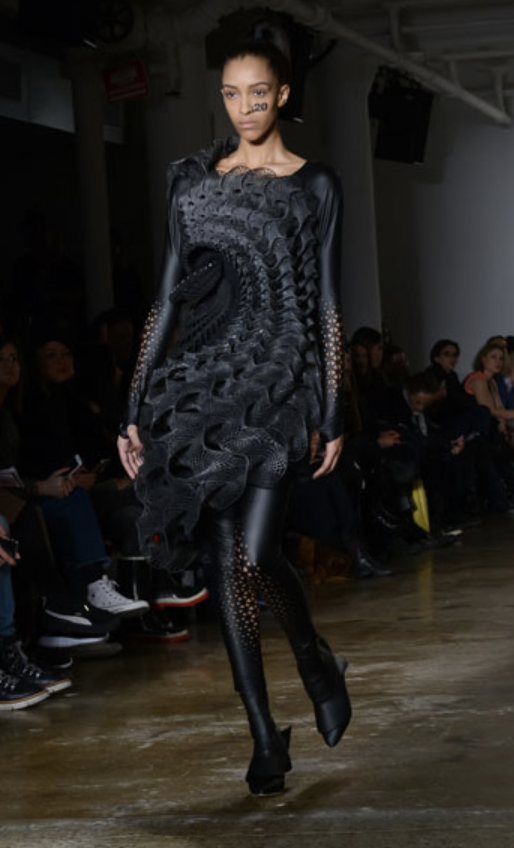Stratasys and threeASFOUR Debut NYFW Collection, Featuring a Dress with Elements 3D Printed Directly on the Fabric

NEW YORK, NEW YORK A model walks the runway during threeASFOUR Runway Show hosted by Klarna STYLE360 NYFW on September 11, 2019 in New York City. (Photo by Thomas Concordia/Getty Images for Style360)
As is the case with many other industries, from aerospace and medical to automotive and military, 3D printing has been infiltrating the world of fashion…and what better venue to highlight the combination of technology and textiles than New York Fashion Week? Held in September and February, the semi-annual New York Fashion Week (NYFW) series of events is one of the world’s four major fashion weeks.
Years ago, New York City design firm threeASFOUR founded an avant garde fashion label that frequently uses 3D printing in its garments, which we’ve seen at previous NYFW events. For the September 2019 series, the company teamed up again with frequent collaborator Stratasys for a truly innovative runway look: the first high fashion garment with elements that were 3D printed directly onto the fabric itself. The Chro-Morpho collection, introduced at the firm’s fall/winter runway show, shows that 3D printing on clothing has commercial potential.
“This has significant implications from a business perspective,” Craig Librett, the Senior Public Relations & Public Affairs Manager for Stratasys, told us. “Instead of creating elements separately – and manually affixing them later – this new technique enables fashion houses and brands to develop hundreds of exclusive pieces with 3D printed elements that can be sold and worn on the mass market.”
 With a few exceptions, most 3D printed fashion consists of elements that are 3D printed separately, and later affixed to the garment itself. But Stratasys believes that 3D printing directly onto textiles could really help open up the technology’s “commercial viability” in terms of functional, flexible, and modern apparel.
With a few exceptions, most 3D printed fashion consists of elements that are 3D printed separately, and later affixed to the garment itself. But Stratasys believes that 3D printing directly onto textiles could really help open up the technology’s “commercial viability” in terms of functional, flexible, and modern apparel.
“Within the next two years, I believe consumers will be able to purchase an array of 3D-printed garments from high-fashion brands. And the result will be access to an explosion of unique color and texture combinations that are simply not possible through traditional methods,” Stratasys Art, Design and Fashion Director Naomi Kaempfer said in a press release.

NEW YORK, NEW YORK A model walks the runway during threeASFOUR Runway Show hosted by Klarna STYLE360 NYFW on September 11, 2019 in New York City. (Photo by Thomas Concordia/Getty Images for Style360)
Stratasys worked with threeASFOUR and fashion designer Travis Fitch to create the Chro-Morpho collection, which was inspired by the color morphology and light filtering of butterly and insect wings. For instance, a Greta-Oto dress from the collection uses a lenticular effect, engineered by Stratasys, to play with both color and light – spherical cells made of photopolymers the size of fish scales were 3D printed directly onto polyester, which causes the piece’s color to shift each time it moves.
“We’ve created the skin-like illusion of switching shades and depth to portray the insect’s innate camouflage, color diversion and luminosity. With 3D design and printing, we’ve embodied the fragility and light wing movement of the butterfly. It’s a stunning display of nature, fashion and technology,” explained Adi Gill, Co-Founder and Creative Director of threeASFOUR.
The dress has 27 parts made up of thousands of cells – each piece is made up a clear lens that contains strips of color inside. All told, it took about 17 hours to 3D print the polymers onto the dress using the Stratasys J750 3D printer, which just made its NYFW debut but has been previously used in fashion 3D printing.
 The full-color, multimaterial PolyJet 3D printer is able to produce over 500,000 different combinations of colors, gradients, textures, and transparencies. Designers can enjoy more design freedom, as the system is able to handle the microscopic layers and delicate geometries of 3D printed garments, and the J750 is also beneficial to a designer’s business, as it can replace multiple manufacturing machines, make the supply chain simpler, and save on time, cost, and space.
The full-color, multimaterial PolyJet 3D printer is able to produce over 500,000 different combinations of colors, gradients, textures, and transparencies. Designers can enjoy more design freedom, as the system is able to handle the microscopic layers and delicate geometries of 3D printed garments, and the J750 is also beneficial to a designer’s business, as it can replace multiple manufacturing machines, make the supply chain simpler, and save on time, cost, and space.
This latest NYFW project with threeASFOUR and Fitch is a major step forward for Stratasys in its quest to combine 3D printing with fashion for high-end clothing and, hopefully, series production in the future, for those of us who can’t afford clothing pieces right off the runway. According to Kaempfer, 3D printed fashion is more about working with fabric materials, instead of just replacing them.
“Soft, lithe fabric touches the skin, while 3D-printed designs adorn the outer garment,” Kaempfer said. “This approach, developed through months of collaboration and testing, was the only way to realize the designers’ vision. It brings the intricacy, nuance and splendor of the dresses to life.”
In order to encourage artists, designers, engineers, and scientists to explore using 3D printing for fashion, Stratasys is also providing its PolyJet technology to the European Union Re-FREAM program, which is funded by the EU’s Horizon 2020 program and part of the broader Science, Technology & the Arts (STARTS) initiative.
Kaempfer explained, “We are always looking to revolutionize manufacturing methods, pioneer new design options, and inspire designers and students to create without boundaries. Our mission is to change the way people think about design and to redefine what’s possible.”
The collaborative, 3D printed Chro-Morpho collection will travel around to museums across the US once NYFW is over. Starting on October 21st, you can see it on display for yourself at the Philadelphia Museum of Art’s “Designs for Different Futures” exhibition, and in 2020 the collection will head to both the Art Institute of Chicago and the Walker Art Center in Minneapolis, Minnesota.
Discuss this story and other 3D printing topics at 3DPrintBoard.com or share your thoughts in the Facebook comments below.
[Images: Stratasys]
The post Stratasys and threeASFOUR Debut NYFW Collection, Featuring a Dress with Elements 3D Printed Directly on the Fabric appeared first on 3DPrint.com | The Voice of 3D Printing / Additive Manufacturing.
Why 3D Printing Needs to be in the Modern Fashion Designer’s Skillset
The world of 3D printing is constantly evolving. Historically its primary use has been in engineering, but it is now poised to revolutionise the fashion industry, changing how we produce anything and everything wearable such as shoes, dresses and accessories. While 3D printing isn’t ubiquitous in high street stores just yet, the inclusion of it in recent runway shows is proving its worth for designers and its exciting potential in fashion.
The fashion industry has historically been slow to adopt the latest technology, but recent years have been characterised by a digital revolution. From e-commerce stores to IoT and wearables, the use of technology in fashion is widespread, and will only increase with time. Just as those emerging technologies have started to change the industry, 3D printing is poised to do the same.
Why 3D fashion?
3D printing is starting to broaden the traditional boundaries of design and allow designers to quickly turn some of their most testing design concepts into reality. It allows designers to create completely new designs that were simply too complex, challenging or time consuming using traditional techniques. Now that 3D printing is easily accessible, we’re starting to see more original 3D designs infiltrate the runway.
For example, Iris Van Herpen incorporated 3D printed ‘face jewellery’ into her catwalk look at the 2019 Paris Fashion Week. This original, customisable content is something that 3D printing allows to be easily designed and created not just only on a small scale, but also en-masse. This level of originality is unprecedented and is one that a designer would struggle to achieve without 3D printing technology, enabling Van Herpen to design the jewellery that was truly unique to the wearer and customised to fit their face perfectly.

“Cellchemy” facemask by Iris Van Herpen.
Van Herpen has also used 3D printing in a lot of her high-profile fashion pieces, to bring her couture visions to life. Her first 3D printed design featured in 2010 and since then she has taken the fashion world by storm with her bespoke, original designs. In 2017, Cara Delevingne wore a stunning bespoke 3D printed dress to the premier of Valerian and the city of a Thousand Planets. Continuing her star-studded client list, she also designed a dramatic 3D printed dress for Beyoncé in her music video ‘Mine’.
Fashion has also dominated the runway at New York Fashion Week on numerous occasions but notably in 2016. threeASFOUR and Travis Fitch worked harmoniously to produce two breakthrough, truly unique dresses, highlighting the originality that 3D printing can help a designer achieve. Following the walk, Gabi Asfour from threeASFOUR credited the functionality that 3D printing provided to enable them to design and make a new textile that didn’t already exist to work with all the desired features of the dress. Something that may not have been possible within the original boundaries of design.

3D printed Harmonograph Dress [Image: Matt Carasella]
3D printing in mass fashion
While 3D printing is helping high push the boundaries of design in end fashion, everyday garments are starting to be feel its influence. Consumers today are always looking for the latest technologies and design techniques in their clothes, and brands are beginning to respond.
The footwear giants, Adidas and Nike have both in recent years incorporated 3D printing into their trainers and demonstrated that 3D printing can offer consumers improved customisation and more sustainable products.

Eliud Kipchoge winning the 2018 London Marathon wearing 3D printed Nike trainers.
3D printing has firmly found its place in marathon running by being the 2018 winning shoe of runner Eliud Kipchoge. Following a disaster in 2017 where his shoes became wet and heavy, Nike turned to 3D printing to reduce the weight of his trainers and personalise them bespoke for his needs. This was not the first time Nike has used 3D printing to provide personalised trainers for elite long-distance runners, created differently to suit their specific needs. This level of personalisation is on a case-by-case basis, but Adidas has found a way of bringing 3D printing to the mass market.
Quick customisation whilst maintaining originality are two more huge opportunities for 3D printing. Garments can be created to perfectly fit the size of each individual body, opening the door for true personalisation. Adidas has implemented the use of customisation into their Futurecraft designs by making a 4D trainer with a 3D printed midsole, this allows a high level of customisation to reach the mass market easily.
As this is a relatively new field, the fashion industry as a whole needs to challenge what they already know and visualise a future with 3D printing in order to see its true value. The incorporation of 3D technology into these designs make them truly original and gives the consumer the high-quality item they desire.
Although the cost of the production may be initially higher, shipping, transport and packaging costs are drastically reduced as a customer can be sent the design and can then print the product themselves.
Education
3D Printing is the future of fashion, enabling enhanced originality to be implemented into all aspiring designer’s skillset. Education and technological advancements are making it cheaper, easier and more beneficial for designers to use 3D fashion in their designs and in turn, produce more quality fashion and make it accessible to all.
As a result, many fashion academies are incorporating 3D printing into their education programmes. Manchester Met University has integrated 3D printing into their education programmes and have successfully produced a 3D knitted structure that is high in both stretch and elasticity. By integrating 3D printing into their education programme, it can be at the forefront of a modern designer’s mind when they are working professionally.
While educating a new generation of designers on 3D printing will be a gradual process, it paves the way for this technology to become part of the mainstream and increase its uptake and use across the industry.
The future of 3D printing in fashion is one that is certainly bright and optimistic, with smaller, user-friendly 3D printers such as the da Vinci nano available to all, the opportunity to learn about the technology isn’t limited to engineers or more technical professions. By allowing even the smallest fashion houses to try this technology, we’ll see more and more 3D printed fashion coming to our stores – and I look forward to seeing how it benefits us all.

